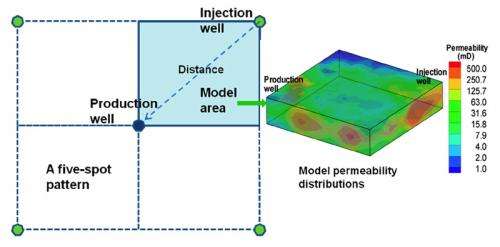Optimize carbon dioxide sequestration, enhance oil recovery

(Phys.org) —Los Alamos researchers and collaborators from the University of Utah have created a generic integrated framework simulation to optimize carbon dioxide (CO2) sequestration and enhance oil recovery (CO2-EOR) based on known parameter distributions for a depleted oil reservoir in Texas. CO2-EOR is a technique in use for over 40 years to produce oil from depleted reservoirs by injecting CO2 along with water. Because a large portion of the injected CO2 remains in place, CO2-EOR is an option for permanently sequestering CO2. The simulation provides an important approach to estimate the potential of storing CO2 in depleted oil fields while simultaneously maximizing oil production. The journal Environmental Science & Technology Letters published the research.
Significance of the research
CO2-EOR provides about 5 percent of the total U.S. current crude oil production. Due to carbon capture and storage technology advances, prolonged high oil prices and the potential availability of large anthropogenic CO2 sources, CO2-EOR could expand in the next few decades. The technology uses water-alternating-with-gas cycles to control CO2 mobility and CO2 flood conformance and to tackle the clogging and scale issues in the depleted reservoir.
However, there are a few operational and technical issues to be resolved for CO2-EOR expansion to commercial scales: 1) uncertainty in characterizing CO2-water-oil systems in depleted reservoirs, 2) lack of robust guidelines for determining injection and production well distances, 3) difficulty in determining the time ratio for water alternating CO2 gas injection, and 4) difficulty in controlling the CO2 flood conformance and monitoring the flood performance. If the first three issues can be quantitatively evaluated and solved, the results will indirectly help solve the fourth issue of CO2 flood conformance and performance evaluation.
The LANL and University of Utah researchers developed a generic integrated framework simulation to optimize CO2 sequestration and enhance oil recovery based on known parameter distributions for a depleted oil reservoir. The framework consists of a multi-phase reservoir simulator coupled with geologic and statistical models. The results from this study provide insights to understand the potential and uncertainty of commercial-scale CO2-EOR.
Research achievements
The team conducted an integrated simulation of CO2-water-oil flow and reactive transport, followed by a global sensitivity and response surface analysis. The source of CO2 used by the test came from a fertilizer plant in Borger, TX, and an ethanol plant in Liberal, KS. The results optimized the CO2-EOR process. The scientists found that the reservoir permeability, porosity, thickness, and depth are the major reservoir parameters that control net CO2 injection/storage and oil/gas recovery rates. The distance between injection and production wells and the sequence of alternating CO2 and water injection are the significant operational parameters to design a five-spot CO2-EOR pattern that efficiently produces oil while storing CO2.
More information: "An Integrated Framework for Optimizing CO2 Sequestration and Enhanced Oil Recovery." Zhenxue Dai, Richard Middleton, Hari Viswanathan, Julianna Fessenden-Rahn, Jacob Bauman, Rajesh Pawar, Si-Yong Lee, and Brian McPherson. Environmental Science & Technology Letters (2013). DOI: 10.1021/ez4001033
Journal information: Environmental Science & Technology Letters
Provided by Los Alamos National Laboratory


















